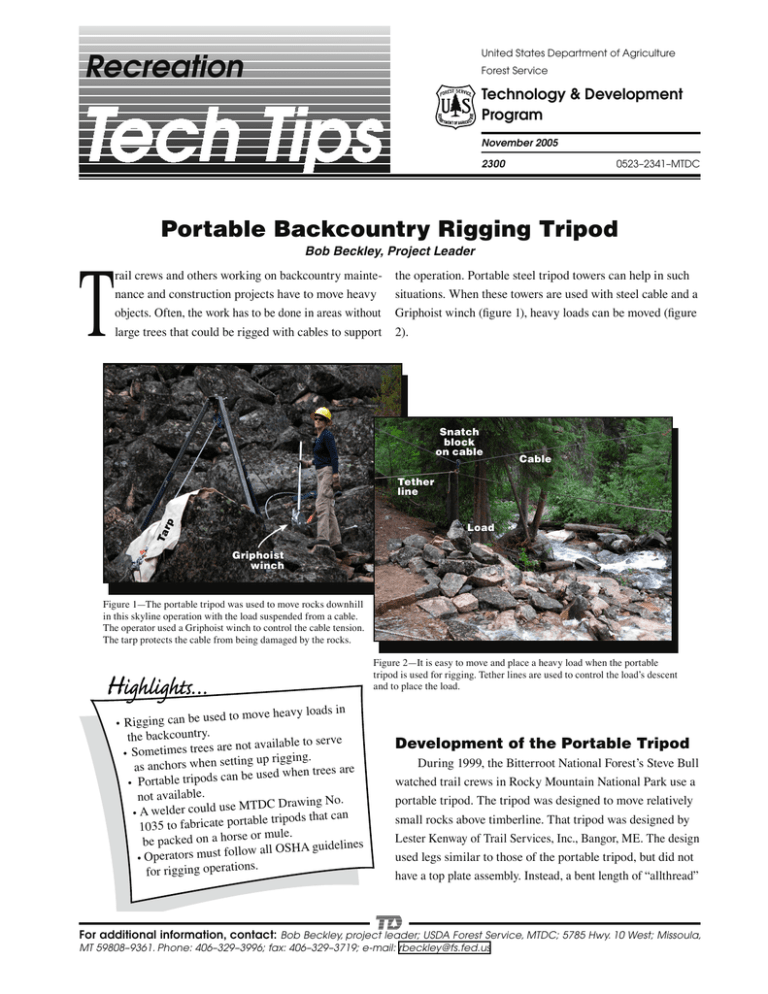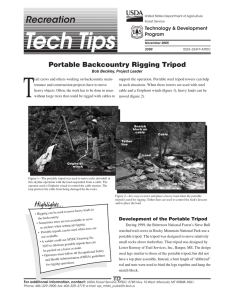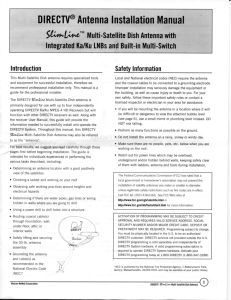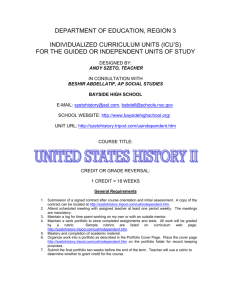T Recreation Portable Backcountry Rigging Tripod Technology & Development
advertisement

Recreation United States Department of Agriculture Forest Service Technology & Development Program November 2005 2300 T 0523–2341–MTDC Portable Backcountry Rigging Tripod Bob Beckley, Project Leader rail crews and others working on backcountry maintenance and construction projects have to move heavy objects. Often, the work has to be done in areas without large trees that could be rigged with cables to support the operation. Portable steel tripod towers can help in such situations. When these towers are used with steel cable and a Griphoist winch (figure 1), heavy loads can be moved (figure 2). Snatch block on cable Cable Ta rp Tether line Load Griphoist winch Figure 1—The portable tripod was used to move rocks downhill in this skyline operation with the load suspended from a cable. The operator used a Griphoist winch to control the cable tension. The tarp protects the cable from being damaged by the rocks. Figure 2—It is easy to move and place a heavy load when the portable tripod is used for rigging. Tether lines are used to control the load’s descent and to place the load. • in to move heavy loads Rigging can be used the backcountry. rve are not available to se • Sometimes trees g. gin ng up rig as anchors when setti be used when trees are n ca ds • Portable tripo not available. No. use MTDC Drawing • A welder could can t tha ds po rtable tri 1035 to fabricate po le. or mu be packed on a horse all OSHA guidelines w llo fo st • Operators mu . for rigging operations Development of the Portable Tripod During 1999, the Bitterroot National Forest’s Steve Bull watched trail crews in Rocky Mountain National Park use a portable tripod. The tripod was designed to move relatively small rocks above timberline. That tripod was designed by Lester Kenway of Trail Services, Inc., Bangor, ME. The design used legs similar to those of the portable tripod, but did not have a top plate assembly. Instead, a bent length of “allthread” For additional information, contact: Bob Beckley, project leader; USDA Forest Service, MTDC; 5785 Hwy. 10 West; Missoula, MT 59808–9361. Phone: 406–329–3996; fax: 406–329–3719; e-mail: rbeckley@fs.fed.us 1 rod and nuts were used to bind the legs together and hang the snatch block. In 2003, the Bitterroot National Forest trails program needed a portable tripod to install bridge stringers weighing more than 1,000 pounds that were being packed by stock to a remote location. Steve Bull created a conceptual design for a tripod head with the assistance of Charlie Mabbott and the leadership of Nick Hazelbaker. Sam Allsop of California State Parks had a top plate assembly design of his own. Bull Hitch pin Hairpin created a modified design based on Allsop’s design. cotter Later, engineer Dick Karsky at MTDC was asked to provide material strength data to assure that the tripod system could handle heavy loads safely. Kent Niles, a local welder and fabricator, built a set of tripods. Niles altered the top plate Figure 4—The tripod’s adjustable legs are locked in place using hitch pins assembly design slightly (figure 3), made the foot and plate with locking hairpin cotters. Tripods Top plate assembly Figure 5a. Snatch block Figure 3—The tripod’s headplate with a snatch block and cable hanging below it. Operators must follow all Occupational Safety and Health Administration regulations for rigging operations. Cable, blocks, and Griphoist Figure 5b. assembly one piece, and used trailer hitch pins with locking hairpin cotters (figure 4) to adjust the legs. Niles delivered the tripods during the summer of 2003. Bitterroot National Forest employees have used these Figures 5a and 5b—The portable tripod can be transported into the tripods many times, transporting loads weighing up to 1,200 backcountry by mules. One mule carries the tripod while another mule carries the block, Griphoist, and cables. pounds. Any organization that needs to move heavy loads over short distances using equipment that can be packed to a remote location (figures 5a and 5b) should consider trying this versatile piece of equipment. 2 When two tripods are needed, snatch blocks should be Rigging operations can be dangerous. Equipment failure used to suspend the cable from the top of the tripods. The blocks reduce wear on the cable and help prevent the tripods can lead to serious injury or death. Equipment must be inspected frequently to ensure it is in good, safe working condi- from being pulled over as the winch pulls in cable. The wire tion. Pay special attention to frayed, bent, or kinked cables. rope cable between the tripods must always have some deflection. Post signs to warn people of the dangerous work (figure They need to be repaired or replaced. Employees working on or near rigging operations must be 6a) and tie flagging on rigging cables (figure 6b). informed of the hazards and receive proper training. A Job Hazard Analysis must be completed and signed before starting a rigging operation and a safety briefing should be held before the start of each day’s work. Currently, the Forest Service does not have a certified Rigging Training Program. On-the-job training should be done Figure 6a. by only those experienced in the type of rigging operations required and using equipment with which they are familiar. All rigging operations will follow applicable OSHA guidelines, such as 1910 Subpart N—Materials Handling and Storage. Private industry, State, or local technical schools may offer training or classes in rigging operations. Consult with your forest’s safety officer before conducting a rigging operation. Safety and Training Building and Using the Portable Tripod The tripod is made from steel tubing and plates that are welded. It breaks down into sections that can be transported easily and that can be reassembled quickly using hitch pins with locking hairpin cotters. The leg sections are just 6 feet long so they can be packed on a horse or mule. MTDC Drawing No. 1035 was prepared based on the Bitterroot National Forest’s tripods. Fabricators must adhere to accepted welding practices and comply with the callouts in the drawing’s materials list to assure that the tripod can support heavy loads safely. The tripod was designed to be used with a materials handling winch, such as the Griphoist-Tirfor model TU–28 (pulling capacity of 4,000 pounds). Operators must ensure that the wire rope, blocks and fittings, and anchor points are Figure 6b. Figures 6a and 6b—Signs should warn people about work occurring in the area. Rigging support cables must be flagged so workers do not trip over them or walk into them. Tripods can lift heavy objects, but are dangerous when loads pull to the side. Crews should not attempt to pick up or drag heavy loads that are not directly under the overhead cable (figure 7). If the load is off to the side of the cable, the in good working condition and are compatible with this load. tripods should be moved so that the load is directly beneath They must observe all Occupational Safety and Health Admin- the cable. Otherwise, one or both of the tripods may tip istration guidelines for the use of cable clamps, safety latches, over. chains, and slings. 3 4. 5. Chain 6. 7. Figure 7—One portable tripod can be used by itself when lifting heavy objects, such as one end of a log bridge. The safety chain around the bottom prevents the legs from spreading too far apart. Hooks welded near the bottom of each leg hold the chain in place. Assembling and Setting Up the Tripods The part numbers are shown on MTDC Drawing No. 1035. Before assembling a tripod, gather all the parts. Run the cable through the snatch block and choose a location where the cable can be anchored near each of the tripods. Assembly Steps 1 Attach the eyebolt (No. 11) to the top plate assembly (No. 7). 2. Attach the three legs (No. 1) to the top plate assembly (No. 7) using the hitch pins and hairpin cotters (No. 14). 3. Attach a sleeve (No. 2) to the bottom of each leg (No. 1) 4 8. using a hitch pin and hairpin cotter (No. 14). The sleeve allows the length of the tripod’s legs to be adjusted. Depending on the type of ground under the tripod, attach the foot and plate assembly (No. 4) to each leg (No. 1) using a hitch pin and locking hairpin cotter (No. 14). Attach the snatch block (with the cable running through it) to the eyebolt. With the assembled tripod lying on the ground and with plenty of slack in the cable, have one person pull one leg of the tripod forward while two persons push the other two legs up until the tripod is standing. Adjust the lengths of the legs until the tripod head is relatively level, keeping the legs evenly spaced. Using a level, make small adjustments to the legs so the tripod head is level, keeping the legs evenly spaced. 9. Attach the chain to the hook on each of the foot and plate assemblies. The chain prevents the legs from spreading. 10. After completing the rigging setup (connecting the cable to the anchors, attaching the Griphoist to the cable, attaching the load to the snatchblock, and attaching a tether line to the load) load the cable slowly and gently. If the tripods shift, repeat steps 7 and 8 until the tripods are loaded and level. Drawing MTDC Drawing No. 1035, which follows, shows how to construct the portable tripods. 5 About the Author Bob Beckley received a bachelor’s degree in political science National Forest. Bob was a smokejumper when he joined from the University of Montana in 1982. He began his Forest MTDC in 1990. He works as a project leader, public affairs Service career as a timber technician on the Nez Perce specialist, and blaster. Library Card Beckley, Bob. 2005. Portable backcountry rigging tripod. Tech Tip 0523–2341–MTDC. Missoula, MT: U.S. Department of Agriculture Forest Service, Missoula Technology and Development Center. 6 p. Explains how to assemble and use a tripod to move heavy loads in the backcountry. The tripod’s legs are just 6 feet long, allowing it to be packed by a horse or mule. The tripod was developed by the Bitterroot National Forest. The Missoula Technology and Development Center prepared a mechanical drawing (No. 1035) that would allow a welder to fabricate the tripod. Keywords: cables, hoists, loads, mechanical drawings, safety at work, trail maintenance, trails Single copies of this document may be ordered from: USDA Forest Service, MTDC 5785 Hwy. 10 West Missoula, MT 59808–9361 Phone: 406–329–3978 Fax: 406–329–3719 E-mail: wo_mtdc_pubs@fs.fed.us For further technical information, contact Bob Beckley at MTDC. Phone: 406–329–3996 Fax: 406–329–3719 E-mail: rbeckley@fs.fed.us Electronic copies of MTDC’s documents are available on the Internet at: http://www.fs.fed.us/t-d (Username: t-d, password: t-d) The U.S. Department of Agriculture (USDA) prohibits discrimination in all its programs and activities on the basis of race, color, national origin, age, disability, and where applicable, sex, marital status, familial status, parental status, religion, sexual orientation, genetic information, political beliefs, reprisal, or because all or part of an individual’s income is derived from any public assistance program. (Not all prohibited bases apply to all programs.) Persons with disabilities who require alternative means for communication of 6 Forest Service and Bureau of Land Management employees can search a more complete collection of MTDC’s documents, videos, and CDs on their internal computer network at: http://fsweb.mtdc.wo.fs.fed.us/search program information (Braille, large print, audiotape, etc.) should contact USDA’s TARGET Center at (202) 720-2600 (voice and TDD). To file a complaint of discrimination, write to USDA, Director, Office of Civil Rights, 1400 Independence Avenue, S.W., Washington, D.C. 20250-9410, or call (800) 795-3272 (voice) or (202) 720-6382 (TDD). USDA is an equal opportunity provider and employer.




